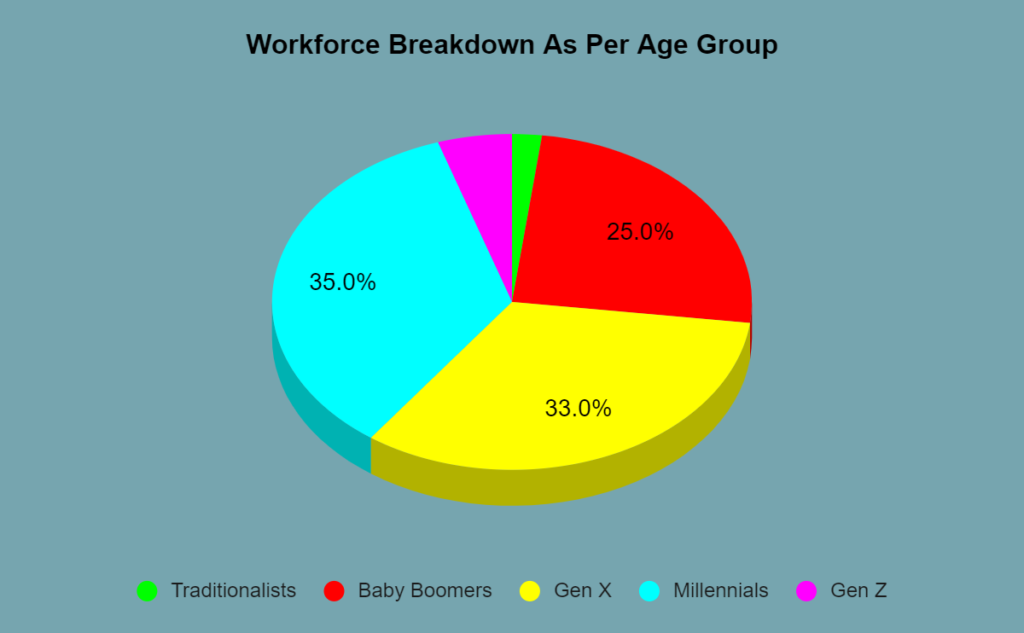eLearning for non-millennials: Let’s understand the nuances of designing a comprehensive program!
A one-size-fits-all concept DOES NOT prove effective when it concerns generational diversity in your workplace. Recent statistics estimate that you can roughly segment the multi-generational workforce in the corporates as follows:

- Traditionalists: 2% (1925-1945)
- Baby Boomers: 25% (1946-1964)
- Generation X: 33% (1965-1980)
- Gen Y AKA Millennials: 35% (1981-2000)
- Generation Z: 5% (2001-2020)
Yes, there are five generations of employees working in almost any organization. And each of them has different learning habits. Now, when you wish to upskill or reskill your employees, you need to address workplace generational gaps. How? By understanding their major traits:

Table of Contents
The Traditionalists
Events like The Great Depression, World War II, radio and movies have groomed the traditional, dedicated, honest, and straightforward Traditionalists. They usually seek respect, recognition, and endeavour to add long-term value to their organization. They additionally prefer communication in the form of handwritten notes and face-to-face discussions.
The Baby Boomers
Work-oriented, holding a positive outlook, and the best performers in teams — traits of Baby Boomers. Events like the Vietnam War, Civil Rights Movement, and Watergate have shaped their views. They opt for efficient communication systems like phone calls and real-time discussions. You can employ Baby Boomers for roles with strict deadlines and mentorship opportunities.
The Generation X

Generation X is a lover of flexibility and independence. Shaped by the AIDs epidemic, the fall of the Berlin Wall, and the Dot-Com Boom, they prefer proper work-life balance, appreciate diversity, and believe in communication styles that generate the best results. However, they are a bit resilient to change if it affects their personal lifestyle.
To upskill the Gen X workforce, employers should have a training system equipped with immediate feedback, flexibility, and the option of personal growth. Since Gen Xers, at 55%, comprise the highest percentage of startups, their training is essential. Additionally, they might outnumber Baby Boomers by 2028. [Source]
The Millennials
The competitive, open-minded, and ambitious Millennials are supporters of diversity. Shaped by Columbine, 9/11, and the Internet, their motivation levels can be upped by additional responsibilities, good management, and unique work experiences. The tech-savvy Gen Y prefers communication channels like IMs, texts, and email.
Millennials love challenges, prefer growth opportunities, and can easily entwine fun with work-life balance. Now, when it comes to learning, managers should address them personally, credit them by results, introduce flexibility, and give instant feedback. If you want some more insights into the learning habits of millennials, you can check out our blog here.
Generation Z
Shaped by the Great Recession and access to technology at a young age, the entrepreneurial Gen Z is progressive but tends to lose interest soon. They love diversity, personalization, individuality, and creativity. Moreover, their preferred communication modes include IMs, texts, and social media. This innovative segment of your workforce is addicted to digital devices, loves independence and individuality, and prefers to work with millennial mentors.
While Millennials and Gen Z are definitely the fastest-growing groups in companies, multiple seniors in the workplace are in several key roles and need to stay skilled and informed as well. We need to keep their learning styles also in mind when designing eLearning methodologies and solutions. So, how can eLearning for Non-millennials be designed to cater to their preferences? We will address this question by mainly focusing on the Gen X segment of your workforce.
eLearning for Non-millennials or the Gen X

Sometimes referred to as the Latch-key Kids, Gen X-ers are more cynical and skeptical as compared to Baby Boomers and Traditionalists. They value independence and self-reliance. These entrepreneurial thinkers carry a lot of resources, experience, and problem-solving skills. While they do not appreciate authority so much, their loyalty is more individual-oriented. Driven by real-world scenarios, Gen X-ers prefer technology over traditional settings.
This section of non-Millenials prefers immediate communication like emails and phones — which provide to-the-point and clear instructions. Not a supporter of micro-management, the Gen X employees respond well to a workplace learning management system, which is realistic, technology-driven, and embedded with games and case studies.
Ad: PlayAblo’s Enterprise-Grade Micro-Learning platform is built for the corporate learner. Micro-Learning, along with assessments and gamification features, ensures learning outcome measurement along with sustained engagement.
Find out more and request a custom demo!
Now, when you decide to implement eLearning for Non-millennials in your organization, you need to understand the aforementioned learning traits of Gen X-ers. For instance, if you design an online training module in an organization where Generation X and Baby Boomers are working in tandem, you might have to address specific requirements of the latter segment.
You may have to begin by educating them on basic steps like — getting online and navigating signs and signifiers. Since online fluency among seniors might not be fluent or natural, you must ensure that you address these workplace learning gaps. On the other hand, Gen X is basically that generation, which invented the online world, and Gen Y comprises those individuals who grew up in it.
Therefore, your eLearning for Non-millennials‘ modules cannot be designed with a one-size-fits-all approach.
It should be flexible. It must have the options of customization — where you can personalize the design and content of each online course. Again, if your eLearning for Non-millennials has extra instructional modules, you might need to put in more effort to engage each age group of your workforce. While digital natives are attracted to gamified apps and quick-access mobile learning management systems, the senior segment of your employees may prefer a simplistic user interface.
Ad: PlayAblo’s Enterprise-Grade Micro-Learning platform is built for the corporate learner. Micro-Learning, along with assessments and gamification features, ensures learning outcome measurement along with sustained engagement.
Find out more and request a custom demo!
Coming back to Gen X-ers, we have already mentioned that they have a strong affinity for innovation, independence, and self-direction. Therefore, eLearning for Non-millennials should arrive with more choices of formats or topics. If they are not motivated to complete the course, they might drop out of the curriculum and gather the required information from other sources. Hence, it would be best if you made it a point to offer eLearning for Non-millennials courses, equipped with a library of resources, instead of a spoon-fed syllabus.
Again, your online learning software must also be embedded with options for instant, action-oriented feedback. Only then, you can customize your courses continually. You will get the most out of your training modules only when you keep them relevant to your learners.
The Bottom Line
Your eLearning LMS is powerful enough to cater to the learning needs of any generation. But it is up to you how you manage the software effectively. When you understand the differences in how different age groups absorb training online, you can design a full-fledged, flexible, and comprehensive eLearning for Non-millennials platform.







4 Comments
Comments are closed, but trackbacks and pingbacks are open.